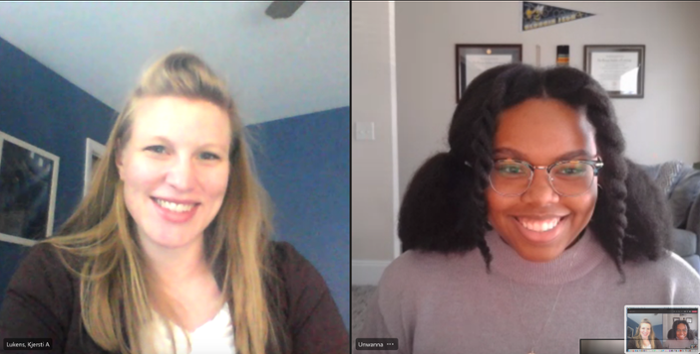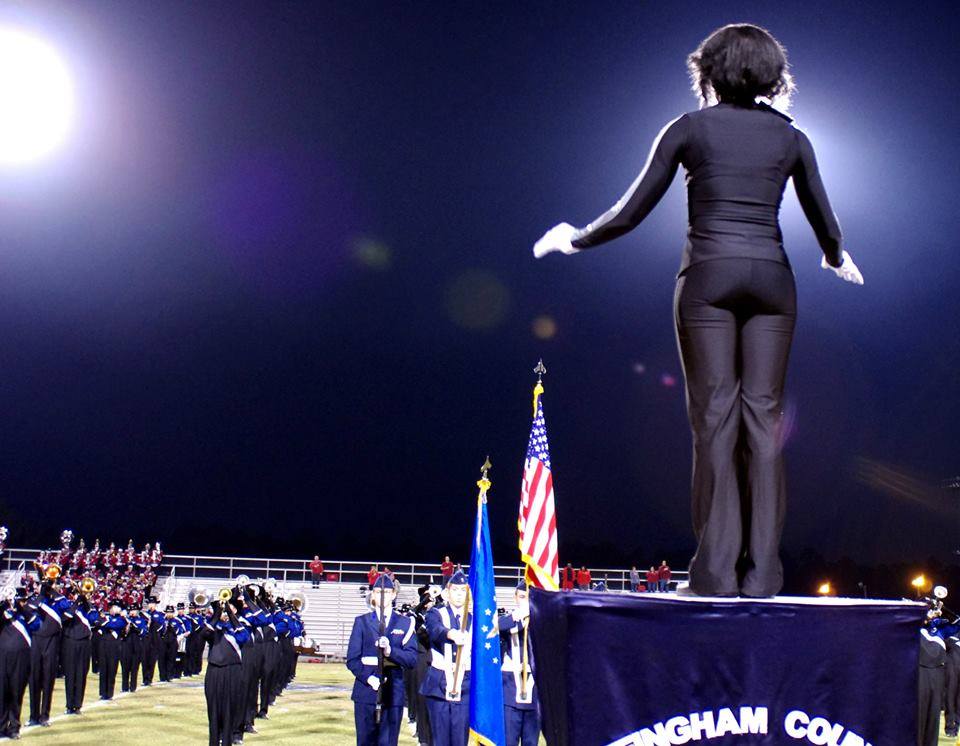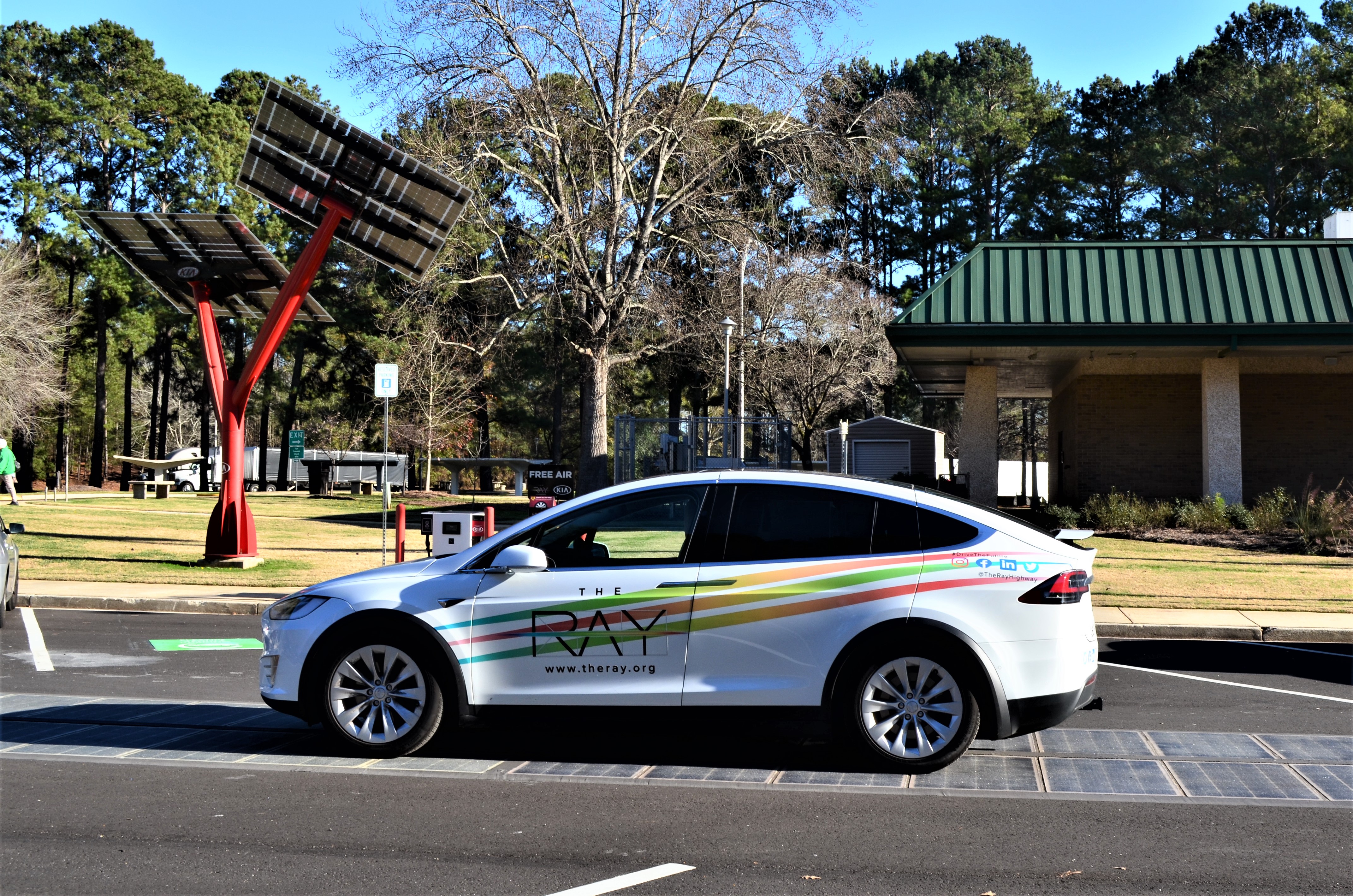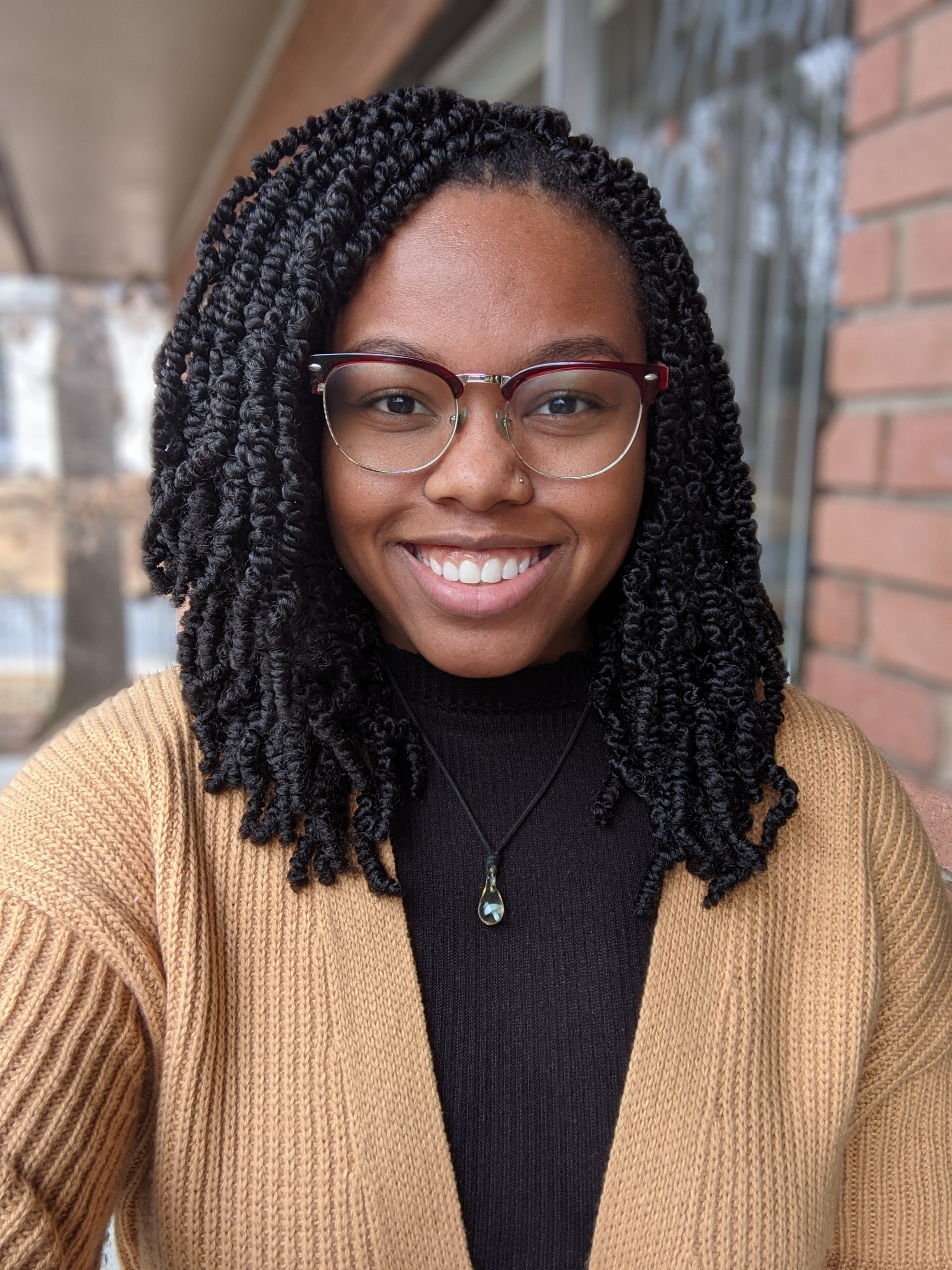Marching band enthusiasts, rejoice! Unwanna Etuk (pronounced oo-WAH-nuh, EH-tʊk) (BS INTA ’19), partnership coordinator and research analyst at The Ray, credits band with kicking off her sustainability journey. In this latest installment in our series of profiles on sustainability leaders among Georgia Tech alumni, discover how Unwanna translated the leadership skills acquired as a drum major into an early career in sustainability-focused roles. While still in college, she helped the City of Woodstock create its first sustainability plan. She now applies her passion for building a better world to her work at a living laboratory for sustainable highways. On February 14, 2022, Kjersti Lukens, the Ray C. Anderson Center for Sustainable Business’s program support coordinator, spoke with Unwanna to learn more about her background, how Georgia Tech prepared her for her career, and the latest developments on the 18-mile stretch of I-85 known as “The Ray.”

On February 14, 2022, Kjersti Lukens interviewed Unwanna Etuk.
Kjersti Lukens: Thanks for talking with me today! To begin, where did you grow up?
Unwanna Etuk: I’m a Texas native. In the fourth grade, I moved to Memphis for a while and then planted myself in rural, coastal Georgia from seventh grade on.
KL: When did your “sustainability journey” begin?
UE: The unofficial version, according to my mom, is that I begged her to start a compost patch in our backyard when I was in elementary school. Since that didn’t make it into my long-term memory, I’ll say it officially started with high school marching band. At the time, I was the top-ranked saxophonist in the school and going out for a leadership position. Even though I was introverted, very soft-spoken, and only a junior, one of my band directors pushed me to audition for drum major, and I was ultimately selected. I learned a lot of things in that role. As drum major, you don’t have your section anymore. You have to break off and cover the whole ground. I learned to notice things I hadn’t seen before. It could be as simple as pushing the chairs back under a table after a meeting in the cafeteria or picking up sheet music that was left behind. When it was time to start applying to colleges, I decided I wanted to apply my talent to something that is valuable to a larger cause–but doesn’t get much attention.

Learning to lead: In 2013, Unwanna conducted the Effingham County High School marching band from atop the drum major’s podium.
KL: What did you study at Georgia Tech?
UE: I started as an environmental engineering major. After a little bit of soul searching and strategically mapping out my academic trajectory, I ended up pursuing a major in international affairs. I got my B.S. in December 2019, along with minors in global development and Spanish.
KL: How would you describe your Georgia Tech experience?
UE: Classes were so interdisciplinary, and I’m really proud of how creative I got with structuring that unique and diverse educational experience. But I also thoroughly enjoyed all the programming, events, webinars… I would try to time those activities with my classes. I’d think, Okay, if I can catch the red bus, then I can attend this panel… Also, Georgia Tech connected me with many organizations and initiatives off campus. It kept opening doors and plugging me into the community of Atlanta.
KL: In college, did you have an “angels singing” moment–when you knew you really loved sustainability?
UE: I took Professor Kim Cobb’s earth and atmospheric sciences course, “Energy, the Environment, and Society,” in Spring 2017. We had tons of guest speakers and professionals from various sectors who directly engage with sustainability and climate change. They came to inspire us for our semester-long Carbon Reduction Challenge projects. One of our guest lecturers was Jairo Garcia. At the time, he was serving as director of climate policies and renewables with the City of Atlanta. This was before he joined campus more permanently [as a lecturer in the School of City & Regional Planning]. I took notes furiously–about two or three pages, front and back–despite knowing that we were not going to be quizzed on the presentation. He spoke about not eating meat for ten years and shared a statistic: that if you cut beef out of your diet, you could offset more carbon emissions than if you stopped driving a Hummer to work every single day. That blew my mind. I thought, Wow. That’s a huge impact for something so simple! I realized there are so many small things you, industry, and the world can do. It comes down to getting the right information in the right places.
KL: It sounds like Jairo Garcia was a really pivotal person for you.
UE: Man, the energy and passion he has! I remember thinking as I was taking notes, I need to work for this guy! At the end of the talk, he said the City of Atlanta Mayor’s Office of Sustainability (now the Mayor’s Office of Resilience) was looking for interns. I shot up to the front of the room. I thought, Please, remember my name! I ended up getting the summer internship.
KL: That’s the role that led to your project in the Summer 2017 Carbon Reduction Challenge, right? That’s when I first got to know you [as a Challenge coordinator].
UE: Yes. At the time, Rachel McBroom (another student from Professor Cobb’s class) and I were interning. Part of our work involved helping to designate the City of Atlanta as a Bee City USA Affiliate. That involves protecting pollinators, creating habitat, and mitigating and eliminating practices that disturb the populations. We also did community outreach. Rachel had the idea to distribute branded seed packets with information about pollinators, pollinator gardens, and creating habitats. We partnered with the Atlanta-Fulton Public Library system, and we created seed packets that had seeds for native, flowering, and pollinator-attracting plants and flowers and vegetables. The idea was that we would encourage people to plant little flower beds or to encourage more ambitious folks to turn their entire yards into wildflower meadows. Instead of having grass that you have to mow every couple of weeks, you could stop mowing and stop putting that fuel in that lawnmower. Instead of having a lawn, you could have these beautiful and fruitful plants that are more beneficial for pollinators. We also looked into the carbon sequestration potential of having those plants. There were lots of benefits layered into this project.
KL: What was your first job out of college?
UE: In Fall 2018, I started an internship with the City of Woodstock, which wanted to create their first sustainability plan. I ended up staying for about two years, including around half a year after graduating in December 2019. We published the sustainability plan in February 2020, and I stayed on to complete a business plan for one of my recommendations in the plan. Soon after that, I started a fellowship at The Ray, working part time as a partnership research fellow (the organization’s first!) from September through the end of 2020. Then I joined full time.
KL: How would you describe The Ray to someone who’s unfamiliar with it?
UE: It all starts with Ray C. Anderson, who has a very far-reaching legacy. The Ray’s story begins with Ray’s youngest daughter Harriet Langford wanting to honor her father’s impact on his community. She worked with Georgia lawmakers to dedicate a portion of Interstate 85 (originally from LaGrange to West Point, and now from the Georgia-Alabama state line up to exit 18) as the “Ray C. Anderson Memorial Highway.” The story is that on her way home from the dedication ceremony, riding in the car with her husband, Phil [Langford], she had an epiphany: “I just put my dad’s name on a dirty highway.” She realized that was not in line with the legacy he’d left behind. So, Phil started Googling “how to make a highway sustainable”...and didn’t find anything. Harriet couldn’t leave things as they were, though, and ended up working with students in the Georgia Tech College of Architecture to design a vision for a sustainable highway. The report they created laid out technology to look into in order to achieve “mission zero”–the mission of zero carbon, zero waste, and zero death on the highway system. We, as a nonprofit organization and a living laboratory test bed, are working to achieve that mission using the P4–public, private, and philanthropic partnerships–to get new technologies on our operational highway. We’re also working with partners to scale this up across the nation and around the world.
KL: So, what can a highway do to be more sustainable?
UE: Our program areas fall into three buckets: energy, safety, and regeneration. We have over a dozen technologies demonstrated on The Ray Highway. Some of our projects include solar panels in rights-of-way, pollinator-friendly plantings, a solar-powered fast EV charger, a wildflower meadow, and rubber modified asphalt (made from scrapped tires). Another technology is WheelRight, a drive-through station that checks the safety of your tires. You drive through the station, and in five seconds, sensors can measure tread depth and air pressure in your tires to make sure they’re properly inflated. That can have significant impacts on your fuel efficiency and your general driving safety.

The solar-powered EV charging station at the Georgia Visitor Information Center.
KL: What’s your specific role now at The Ray?
UE: I’m The Ray’s partnership coordinator and research analyst. I’m in charge of taking the deep dives into new technologies and potential partners. I also pull together our own research and materials for partners or proposals–to spread the word about what we do.
KL: What gets you most excited about your current role?
UE: Our team has a special bond. We’re on an ambitious mission, but it doesn’t feel like a dream. We are seeing the impact today. We are receiving positive responses from state departments of transportation (DOTs)–and even from the federal government!
KL: What particularly interests the federal government?
UE: In April 2021, the Federal Highway Administration released a memo that provided new guidance for state DOTs, encouraging them to leverage alternative uses of the highway right-of-way, including many practices and technologies already demonstrated on The Ray Highway, such as renewable energy generation, vegetation management, and alternative fueling facilities.

At the right-of-way solar site alongside The Ray, the groundcover management strategy creates habitat for critical pollinating species.
KL: Let’s imagine one of our readers is on I-85. How will they know they’re on The Ray?
UE: If you're driving south from Atlanta, at exit 18 you’ll see the brown DOT sign that says “The Ray C. Memorial Highway.” You’ll also see a sign with our logo. Down the median, depending on the time of the year, you’ll see wildflowers. At exit 14 interchange, and you cannot miss our 2,200 solar panels set against beautiful, rolling hills. It’s breathtaking.
KL: And to come full circle: Do you still play the saxophone?
UE: I don’t. It got broken while I was in college marching band. I thought, Ten years, that’s enough. Time for something else. Now my thing is Latin dancing: salsa, bachata, and others… As a student, I was part of the Georgia Tech Salsa Club. One of the big off-campus events that we loved attending was the Atlanta Salsa Bachata Festival. It’s actually taking place at the end of this month. I’m looking forward to coming up to Atlanta to go dancing!
As told to Jennifer Holley Lux
